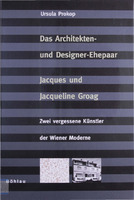Architekten- und Designer-Ehepaar Jacques und Jacqueline Groag
Zwei vergessene Künstler der Wiener Moderne
Author(s)
Prokop, Ursula
Collection
Austrian Science Fund (FWF)Language
GermanAbstract
This manuscript is based on the results of a research project (No. 7726), carried out at the Institute for the History of Art (University of Vienna) under the direction of Professor Dr. Peter Haiko, and sponsored by the Jubilee Funds of the Austrian National Bank.
The artists Jacques Groag (b. Olomouc, February 5, 1892, d. London, January 26, 1962) and his wife Jacqueline (née Hilde Blumberger, b.Prague, April 6, 1903, d. London, January 13, 1986) belong to those representatives of the Viennese Modernists between the two World Wars who are now forgotten, due to the fact that, being Jews, they were forced to emigrate in 1938.
In the early phase of his career Jacques Groag worked as an assistant and executing architect for Adolf Loos (Moller house, 1927) and Ludwig Wittgenstein (Wittgenstein house, 1928) and co-operated with the interior designers Friedl Dicker and Franz Singer (Heller tennis club house, 1928). After that, in independent practice he realized a considerable number of remarkable architectural projects in Vienna and native Moravia (now Czech Republic), among others a pair of semi-detached houses at the Werkbundsiedlung, a house for the actress Paula Wessely, a country house for the industrialist Otto Eisler, several houses for other private clients, but also industrial buildings. At this time he was regarded as one of the most important followers of Adolf Loos. He also enjoyed remarkable success as a designer of interiors, and was befriended to many Viennese artists such as the painters Sergius Pauser and Josef Dobrowsky, the sculptor Georg Ehrlich and the photographer Trude Fleischmann. His wife Jacqueline, a student of Franz Cizek and Josef Hoffmann at the Wiener Kunstgewerbeschule, between the wars was active as a designer of textiles for the Wiener Werkstätte and for fashion houses in Paris. After the couple's emigration to England in 1939 Jacques Groag could only find commissions as a designer of interiors and furniture, but found no opportunity to realize architectural projects. As a team, Jacques and Jacqueline made important contributions to prominent exhibitions on British design in the post-war period. Jacqueline, who outlived her husband for more than twenty years, continued her career as a successful textile designer until her late age. Diese Arbeit basiert auf dem vom Jubiläumsfond der Österreichischen Nationalbank geförderten Forschungsprojekt Nr. 7726 des Institutes für Kunstgeschichte d. Universität/Wien, unter Leitung von Prof. Dr. Peter Haiko
Das Künstlerehepaar Jacques ( *5.2.1892/Olmütz - † 26.1.1962/London) und Jacqueline Groag (recte Hilde Blumberger, *6.4.1903/Prag - †13.1.1986/London) gehört aufgrund des Umstandes, daß sie 1938 als Juden emigrieren mußten, heute zu den vergessenen Vertretern der Wiener Moderne der Zwischenkriegszeit.
Der Architekt Jacques Groag, zu Beginn seiner Karriere Mitarbeiter von Adolf Loos (Villa Moller/1927) , Ludwig Wittgenstein (Haus Wittgenstein/1928) und den Innenarchitekten Friedl Dicker/Franz Singer (Clubhaus Heller/1928), realisierte zahlreiche bemerkenswerte Projekte in Wien und Mähren (u. a. ein Doppelhaus der Werkbundsiedlung, Villa Paula Wessely, Landhaus Eisler, diverse Einfamilienhäuser und Industrieprojekte ) und galt seinerzeit als einer der bedeutendsten Schüler von Adolf Loos. Groag war insbesondere auch auf dem Gebiet der Innenarchitektur sehr erfolgreich und war mit zahlreichen Wiener Künstlern (Sergius Pauser, Josef Dobrowsky, Georg Ehrlich, Trude Fleischmann) befreundet. Seine Frau Jacqueline Groag, eine Schülerin von Franz Cizek und Josef Hoffmann an der Kunstgewerbeschule/Wien, war in der Zwischenkriegszeit als Textildesignerin für die Wiener Werkstätte und namhafte Pariser Modehäuser tätig. Nach der Emigration nach England 1939 konnte Jacques Groag seinen Beruf jedoch nur mehr als Innenarchitekt und Möbeldesigner ausüben, Architekturaufträge blieben aus. Dahingegen wurde Jacqueline Groag mit ihren auf der Ästhetik der Wiener Werkstätte basierenden Stoff - und Tapetenentwürfen zu einer der führenden und einflußreichsten Designerinnen der Nachkriegszeit in England (u. a. Modellkleid für Queen Elizabeth, Aufträge für Bahn - und Schiffahrtslinien). Das Ehepaar hatte als Designerteam auch an mehreren großen britischen Ausstellungen der Nachkriegszeit mitgewirkt. Jacqueline Groag, die ihren Mann um rund zwanzig Jahre überlebte, war bis in ihr hohes Alter erfolgreich tätig.
Keywords
Jacques Groag; Jacqueline Groag; Viennese Modernists; Wiener Werkstätte; Adolf Loos; Architekt; VillaDOI
10.26530/oapen_574824ISBN
9783205773009OCN
742779166Publication date and place
2005Grantor
Imprint
BöhlauClassification
Architecture


 Download
Download